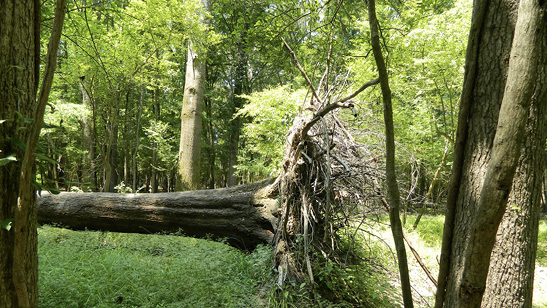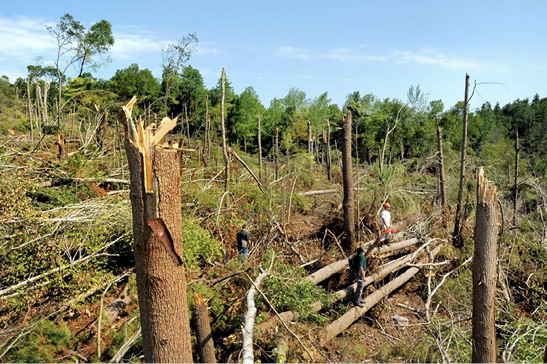Tornado and Straight-Line Wind Damage to Hardwood Stands: Frequently Asked Management Questions
Tornadoes and hurricanes are common in the southern region of the United States. After such events, many landowners in Mississippi face difficult decisions concerning future management of their hardwood stands.
This publication provides information to help landowners make those decisions. However, forest landowners are strongly encouraged to seek the advice of a professional forester or other knowledgeable individuals about hardwood silviculture before making management decisions. At the end of this publication, you will find a list of agencies you can contact for information.
Before addressing particular questions about management of hardwood stands, it is necessary to understand types of damage caused by tornadoes and the resulting effects on trees (mortality, growth rate, value). Common types of damage include the following:
- windthrow (the tree is uprooted and blown down)
- broken stems (in some cases twisted by wind)
- broken limbs
- leaning trees
- bent trees
- trees with major wounds
Often, trees will exhibit a combination of these injuries.
Windthrow (uprooting) damage to hardwood stands is common, and, in the worst cases, almost all stems of commercial value are lost. Large, mature trees are more susceptible to windthrow because the area of mass aboveground is much greater than the root mass (Figure 1). This is an even bigger problem if roots are not sufficiently deep.

If a stand has suffered excessive windthrow, the only viable option is salvage and a complete harvest to regenerate the stand. The questions then become how and when the salvage should be done and how the stand will be regenerated. These decisions will be discussed later.
One fortunate aspect of windthrow is that there is usually less damage to the bole of the tree compared to other types of damage. It is often possible to use the tree for the same products it would be used for if normally harvested. Therefore, decrease in value will be minimal. However, it is still hard to harvest the stand because trees are often stacked on top of one another in random fashion.
High-speed tornado winds can cause stem breakage, especially in younger hardwood trees, as shown in Figure 2. Broken stems in mature hardwood trees often occur at weak areas such as forks or previous injuries that have begun to decay. Broken stems result in far greater value loss in hardwood sawtimber than does windthrow. Splintering, fiber pull, and reduction in merchantable length all limit use of the tree for higher value products such as lumber and veneer. Also, logging cost for salvage is greater when trees are broken.

Broken limbs, including the top of the tree, generally are not as serious a problem in hardwoods as in pines. Hardwood trees may suffer a 50–75 percent loss of crown and be able to survive and establish a new crown (USDA Forest Service, 1998; see Figure 3). However, this depends on the type of breakage. If limbs larger than 3 inches in diameter are broken and cause major wounding to the bole, the tree is not likely to remain sound for long periods (years) because of decay and/or future stem breakage (Figure 4).


Leaning trees are an indication of partial uprooting. If the lean is less than about 45 degrees and there is no other major damage, these trees are very likely to survive and grow at an acceptable rate. It is not necessary to remove them in a salvage cut, although they likely should be removed in the next harvest operation. Bent trees are most common in younger stands of saplings and pole-sized trees. These trees are also capable of recovery and should receive a low priority for removal in a salvage cut.
Boles of standing trees can be severely wounded by falling trees and objects blown during tornados or straight-line winds. These wounds can result in degradation of stems but usually do not result in immediate death of the tree. Except in the case of very severe wounds, trees will continue to grow and remain an important component of stands that can be managed following damage.
Frequently Asked Questions
Can my damaged hardwood stands be managed, or should I harvest standing timber along with the salvage operation?
After a significant weather event, hardwood stands may resemble piles of straw (Figures 5 and 6). In a matter of minutes, decades of growth can be destroyed. It may seem like there is not enough left to manage, but avoid making decisions until you have carefully assessed financial and biological considerations.


If it is economically feasible, you should almost always employ a simple salvage operation to use dead trees or those not capable of responding and growing. However, the question is: Do you have desirable species that will continue to grow and meet your objectives for the stand? Consider severity and type of damage, age and history of the stand, and your long-term objectives. The type and severity of damage is the most important consideration. Tornado and straight-line wind damage may vary from complete blow-down of all commercial timber to simple limb and top breakage.
Before deciding whether to harvest and regenerate or salvage and manage, make a thorough assessment of the stand. Observations from the air or edges of the stand may not be adequate. Concentrate primarily on standing trees and not what could be salvaged, although you can evaluate that at the same time. Your assessment should involve observations/measurements of stocking (trees per acre), composition (Are the standing trees desirable for my management objectives?), type and severity of damage, and distribution of damage (Is it uniform throughout the stand or in patches?). A professional forester with experience in hardwood management may be needed.
Every situation is different and depends on the landowner’s objectives. However, follow these general guidelines if continued production of hardwood timber is a major objective:
- Manage the stand if there are 35 or more trees per acre of desirable species capable of responding and producing good crowns and correspondingly acceptable growth rate.
- Remember that, following extreme weather events, a considerable amount of wood may be on the market, which lowers expected returns to the landowner. If the stand can be managed without significant loss from secondary pests, it may be financially beneficial to delay harvest for a short time.
- If there is only minimal bole or large limb damage, manage the stand. The ability to respond is determined primarily by crown condition. Research has shown that trees with less than 50 percent crown loss are capable of full recovery with some loss of growth (Barry et al., 1998). At 50–75 percent crown loss, many hardwood trees will recover and can be retained for several years, but there will be a substantial loss in growth.
- If providing wildlife habitat (especially hard mast-producing trees) is a major landowner objective, you may want to manage standing trees even at levels less than 35 trees per acre. In either case, management techniques can be altered in these stands as discussed below.
More than 50 percent of trees in my hardwood stand have been either uprooted or severely damaged. What are the disadvantages of harvesting the remaining trees in the salvage operation?
The biggest disadvantage may be a large financial loss. Since a large volume of material will likely be on the market following a tornado, stumpage values are likely to be low. Furthermore, high-value trees are likely to be sold at prices established for salvage material. If the residual stand can be managed for a few years, even with low stocking, stumpage value is likely to increase considerably. Of course, if residual stocking or volume is too low, decreased marketability of your future stand may result in an inability to harvest at a later date. This warrants careful consideration when deciding whether to harvest undamaged trees during a salvage operation.
Another distinct disadvantage is that a complete harvest may eliminate the possibility of natural regeneration for the next stand. If there is no advanced regeneration of desirable species, natural regeneration becomes impossible. If a residual stand can be maintained at even low density, it may serve as a seed source for regeneration purposes. This is similar to regeneration using the shelterwood method.
Complete stand removal may be a viable choice when there is ample advanced regeneration of desirable species. In that scenario, total removal can follow the same process that it would in any final harvest of a managed stand.
How can I determine if I have adequate advanced regeneration of desirable species to initiate a new hardwood stand?
A professional forester or someone with experience in hardwood management should make this determination. However, a simple model was developed by the Mississippi State University Extension forestry department to help landowners make that decision. The model and instructions are available on CD. For this resource, contact the forestry department at MSU. The procedure is also outlined in MSU Extension Publications 3476 Upland Hardwoods: Natural Regeneration and 3461 Bottomland Hardwoods: Natural Regeneration Using the Shelterwood System.
How much time do I have for the salvage operation?
The highest priority for salvage should be given to products with the highest value. If you have both pine and hardwood, remember that pine sawlogs will degrade more rapidly due to degradation by blue stain. Historically this was of greater concern due to the high value of pine sawtimber. With market constraints for pine in 2020, landowners should consider the low value of pine sawtimber and weight their decision for salvaging order based on local marketability and quality of both types of downed/damaged timber. Salvage of pine and hardwood pulpwood may be delayed as long as 8–12 months, but both become increasingly harder to sell as time goes on. Uprooted or broken hardwood sawtimber trees should be salvaged as quickly as possible, but, depending on the weather, salvage can take place for as long as 4–6 months.
In addition to uprooted and broken trees, what type of standing trees should be removed in the salvage operation?
Remove trees that are unlikely to survive to the next harvest operation (5–10 years). This is determined primarily by crown condition and damage to the trunk. As a general rule, trees with more than 75 percent of the crown destroyed should be removed, but some of these could be left for wildlife habitat purposes. Remove trees with severe wounds from breakage that make loss likely.
Additional Sources of Information
Barry, P. J., Doggett, C., Anderson, R. L., & Swain, K. M., Sr. (1998). How to evaluate and manage storm-damaged areas. USDA Forest Service Southern Region, Management Bulletin R8 MB 63.
Hardwood decision models CD. (2005). Mississippi State University Extension.
Long, A., Nowak, J., Demers, C., Williams, R., Strong, N., Davidson, J., & Holzaepfel, J. (2005). Assessment and management of hurricane damaged timberland. University of Florida, IFAS Extension, SS-FOR 22.
Mississippi Forestry Commission. https://www.mfc.ms.gov/
Mississippi State University Extension. http://extension.msstate.edu/
Self, A. B. (2020). Bottomland hardwoods: Natural regeneration using the shelterwood system. Mississippi State University Extension publication 3461.
Self, A. B. (2020). Upland hardwoods: Natural regeneration. Mississippi State University Extension publication 3476.
U.S. Forest Service. (1998). How to determine percent crown loss in hardwoods before leaf-out. USDA Forest Service, Durham, NH, Information Sheet #1.
U.S. Forest Service. (1998). Silvicultural approaches for managing ice-damaged stands. USDA Forest Service, Durham, NH, Information Sheet #4.
Publication 2683 (POD-01-21)
Revised by Brady Self, PhD, Associate Extension Professor, Forestry, from an earlier edition by Randall J. Rousseau, PhD, former Extension/Research Professor, John D. Hodges, Professor Emeritus (deceased), and Andrew Londo, PhD, former Extension Professor.
The Mississippi State University Extension Service is working to ensure all web content is accessible to all users. If you need assistance accessing any of our content, please email the webteam or call 662-325-2262.







